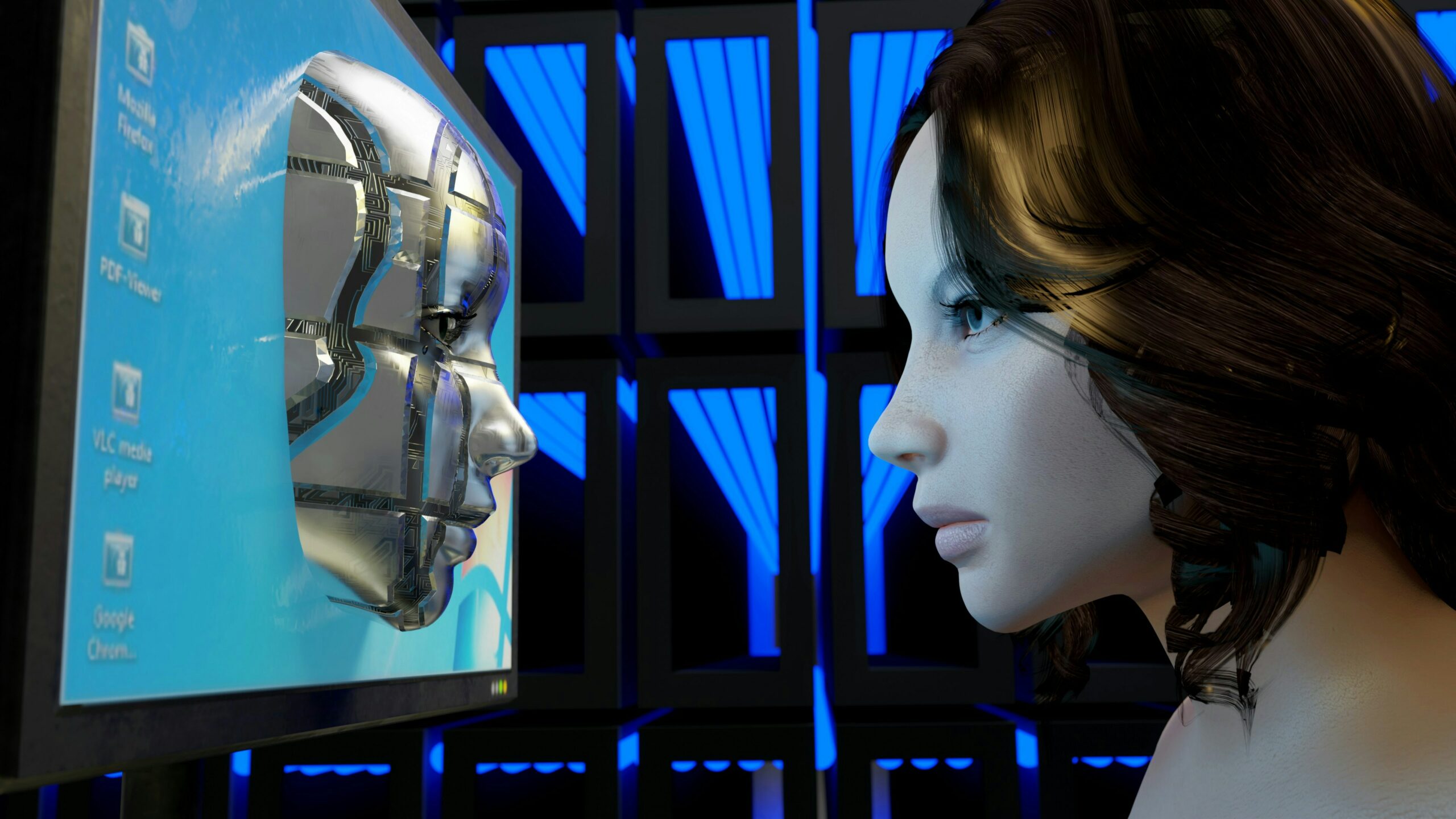We’re wary of touch like never before. Yet fundamentally altering how people interact with technology holds promise and peril for companies.
In brief
- The COVID-19 pandemic is propelling demand for touchless interfaces, accelerating the shift towards sensory interfaces (Zero UI).
- Every customer and employee touchpoint is likely to be revolutionized in a hands-free, screenless world of ambient intelligent interfaces.
- Designing successful touchless environments will require taking a human-centric approach, ensuring reliability, security, privacy and choice.
Remember learning how to navigate the internet? Icons. Drop-down menus. Touching. Swiping. Scrolling. Tapping. It was a whole new way of communicating, designed to translate our intent to computing devices. Now, thanks to novel smart sensors and advances in artificial intelligence (AI), devices are adapting to us through what’s collectively known as “Zero UI” – the effective disappearance of a visual user interface (UI) enabling us to communicate through voice, gestures, and biometric authentication.
Sensory interfaces such as voice assistants and gesture recognition promise to be more intuitive and immediate. They point to a future where the interface is embedded in our environment, enabling frictionless, anticipatory, responsive and predictive interactions. It will change how we access information and make decisions, as well as how we experience and navigate the physical and digital worlds.
Touchless interfaces are even more critical in the era of COVID-19. We’re wary of touch like never before, an aversion likely to persist until a viable vaccine becomes available – and potentially beyond. Reducing or eliminating touch points is essential for safely reopening businesses. The pandemic has crystallized the value proposition of touchless technologies, accelerating their development and deployment.
So, what does this shift toward Zero UI mean for companies? In the short term, touchless interfaces will be necessary for safe indoor environments, from offices to restaurants and retail stores. In the long term, touchless interactions promise a superior user experience, reducing the cognitive load of apps, settings and passwords. Moreover, everything from branding to marketing to customer and employee engagement may be revolutionized in a hands-free, screenless world of ambient intelligent interfaces. Thriving in this future requires taking a human-centric approach, keeping four imperatives in mind: reliability, security, privacy and choice.
Four imperatives for succeeding in a touchless world
The COVID-19 pandemic transformed how many businesses operate, almost overnight. Restaurants turned to voice search platforms, and many are considering voice recognition for ordering when on-site dining reopens. Companies are developing voice solutions for elevators and voice assistants for hotels to handle everything from guest services to checkout. Gesture recognition and control is also emerging, especially in contexts involving sensitive information, such as using an ATM, where voice may not be the best choice. One company is combining gestures with haptic feedback, giving an invisible sense of touch, offering safety and a more familiar tactile mode of interaction.
In addition, contactless authentication is gaining ground. Facial recognition, iris scans, voice biometrics, and more recently, palm vein readers are becoming candidates to replace key card or fingerprint readers at government buildings, offices, factories, hospitals and schools.
Future Consumer Index, October 2020
36%
of global respondents expect to change how they eat out long term; with 31% of this group more likely to choose restaurants that offer digital ordering or contact-less payment.
Future Consumer Index, July 2020
52%
of global consumers will use more contact-less delivery or cashless payments long term to avoid touching things while shopping.
The key for companies is to remember that, ultimately, Zero UI is about delivering a seamless, safe and superior user experience. As Aleksander Poniewierski, EY Global Digital & Emerging Technology Leader points out: “Touchless interfaces will allow us to communicate with cyber-physical systems in a new and more natural way through voice, gestures and glances. While we cannot predict all the consequences of creating these new habits, if implemented thoughtfully and responsibly, these interfaces can provide a competitive advantage.”
Taking a human-centric approach is therefore critical to successful implementation. We recommend four imperatives leaders must keep in mind as they develop touchless interfaces and consider deploying them:
- Reliability – Ensure the technology works for a variety of users and in a variety of environments. Touchless functionality and interaction must be repeatable and reliable if it’s to be accepted and adopted.
- Security – Relying on touchless interfaces like biometrics for authentication and access carries significant risk. Build in two-factor authentication to mitigate breaches and explore using behavioral identifiers, such as physical movements and patterns of engagement, in conjunction with biometric markers as an added measure of security.
- Privacy – Allow users to authorize the use of their data, while providing transparency and control over the data being collected.
- Choice – Users need time to learn new behaviors, so switching exclusively to touchless interfaces risks losing customers. Companies will need to deploy touchless interfaces along with traditional modes of interaction, such as touchscreens and mobile apps, so users have choice in case they are uncomfortable with voice, gestures or biometrics.
“Touchless interfaces will allow us to communicate with cyber-physical systems in a new and more natural way. If implemented thoughtfully and responsibly, these interfaces can provide a competitive advantage. “
Dr. Aleksander Poniewierski
EY Global Digital & Emerging Technology Leader
These interfaces are also qualitatively different from previous ones because of AI, which gives them the ability to hear, see, and crucially, understand humans. Over time and with increased adoption, these AI-embedded interfaces will learn our unique preferences and idiosyncrasies, tailoring every interaction to individual users.
Eventually, as we become more comfortable with and trusting of these interfaces, they will begin to act alongside us and on our behalf. They will help us navigate a more complex digital expanse, curating more personalized search results, delivering increasingly relevant and contextual recommendations and information. In short, they will help customers get what they want faster and make employees more efficient. But we are not there yet.
Challenges to realizing Zero UI
Although voice assistants, gesture recognition and contactless authentication technologies have come a long way to enable this vision, they still face a variety of challenges.
From a technological standpoint, these interfaces have big shoes to fill. They need to have the same operational integrity as touch, working uniformly and universally for every single user, every single time. But even today, voice recognition systems stumble when it comes to accents or noisy environments. Gesture recognition systems can’t recognize hand movements in poor lighting or if they are imprecise or done too quickly. And AI-based biometric technologies like facial recognition or iris recognition have been criticized for bias against certain demographic groups.
These shortcomings all risk frustrating users, especially if initial interactions are not immediately successful. Moreover, existing touchless technologies are unable to perceive user context or predict user intent.
Overcoming these drawbacks requires improving the underlying AI algorithms that power these interfaces, enabling them to deliver contextual, personalized and ambient experiences. But doing so means collecting extensive personal data to build detailed profiles of users, including preferences, desires, routines and behaviors in different contexts. This may exacerbate existing privacy concerns, potentially discouraging users from engaging with touchless interfaces.
In addition, security will gain new importance, especially when it comes to biometric authentication. When a password is stolen or credit card details are hacked, we can simply change our password and get a new card. But when our iris scan or facial recognition data is stolen, these cannot be readily changed. Although “liveness” detection may mitigate some risk for face recognition, it doesn’t lend itself to iris or palm scans.
Undoubtedly, these challenges will be resolved, especially given the uptick in demand resulting from the COVID-19 pandemic. Technology companies and start-ups are working to make these interfaces more robust, while governments are developing regulations to safeguard privacy and promote responsible use of personal data. Companies looking to harness the capabilities of Zero UI will need to consider the implications and prepare for them to be successful in a future of invisible interfaces.
For now, the technologies powering Zero UI are not fully mature, and it is likely touchless interfaces will co-exist with touchscreens and mobile apps in the short term. However, as progress is made and advances in AI allow devices to act independently, companies will need to rethink everything from branding and marketing to customer and employee engagement. When the main medium of engagement shifts to non-visual modes, how will companies brand the experience? And how will they market to voice assistants that curate products and services on behalf of the user?
Summary
Zero UI presents a significant shift in the human-machine relationship, and companies will need to transform how they approach digital engagement in a world of no-UI.

 5.0
5.0 





















